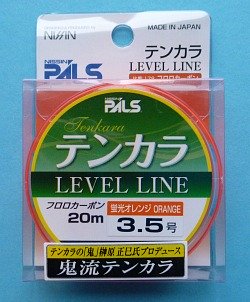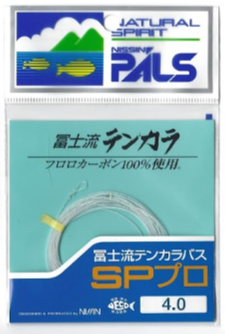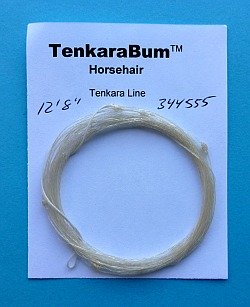Tenkara Line
The first tenkara line was made from twisted horsehair. Most are now made from nylon monofilament or fluorocarbon fishing line. The two main types are tapered lines and level lines. In the US, most tapered lines are really just long furled leaders. Most level lines in both the US and Japan are fluorocarbon.
If there is one area of tenkara fishing
where I get away from the simplicity, it is with the lines. You can
certainly choose one line, either tapered or level, and do all your
fishing with it. I like to fine-tune things a bit and prefer to use
different lines with different rods. To some extent, I'll also match the
line to the fly, using heavier lines with heavy or wind resistant
flies. I also match the line to how much of a breeze there is.
As with everything else in life, the choice of which tenkara line to use is a compromise. Each type has advantages and disadvantages. I believe that anglers in Japan pretty much choose to fish tapered or level lines, and don't switch back and forth.
To me, the greatest single advantage of tenkara over Western fly fishing is the improved presentation. The long rod and relatively short line allow you to keep most of your line off the water and fish a tighter line. With aerial mending moving the rod tip to one side as you end your forward cast, you can align the tippet that is in the water to the current, which can keep your wet fly near the surface or allow it to sink further, depending on whether you keep the tippet downstream of the fly or upstream of the fly. You can also manipulate the fly more easily, giving it the appearance of life.
For years, I recommended fishing the lightest line you could get away with. A light line is easier to hold off the water's surface, and keeping a hi-vis line off the water at all times is directly related to catching more fish. Hi-vis line in the water alerts the fish much more so than hi-vis line in the air.
You cannot eliminate line sag entirely, nor would you want to. The amount of sag in your line is an extremely sensitive strike indicator. When a fish hits your fly, the fly either stops its downstream drift or moves in a different direction, which could be down towards the stream bottom, to one side or even upstream depending on where the fish goes after taking your fly. Any of those movements will change the amount of sag in your line, which will be a visible indication of the strike. Better yet, taking up the slack of the line sag does not cause any tension on the line for the fish to feel, so you will know it's there before it knows you're there.
I would recommend fishing a hi-vis line, though, as I am convinced that that the better you see your line, the better you'll see what are occasionally very subtle movements in the line. Some strikes are violent, but some are extremely subtle.
To some extent, how light line you can fish will depend on your
rod, the flies you are fishing, and whether there is any breeze. Casting into a breeze or casting a wind-resistant fly requires a heavier line.
I now mostly agree with John Vetterli's view regarding line choice, which is to use the line which best loads the rod. Stiffer rods need heavier lines. As a general rule, for a Nissin 6:4 rod or a soft seiryu rod I might use a size 3 level line, while I might go to a size 3.5 for a Nissin 7:3 rod and a size 4 with a Daiwa Kiyose SF or Keiryu-X. For some rods, such as the TenkaraBum 36 and 40, which will fish a rage of line sizes well, I'd choose based on the fly or the breeze.
If you want to embrace the simplicity of tenkara, this section should help you pick which line to use. If you want to fine-tune things to match your lines to your rods, flies and weather, this section should help you pick which line to use when.
Line Length
Line length is mostly a matter of personal preference and the place where you are fishing. You may want to use a shorter line when fishing a very narrow, overgrown stream and a longer line in a river or lake.
As a starting point, though, I would suggest a line about equal to the rod length, plus about 4.5' of leader and tippet. Most tenkara anglers scoff at the idea of a leader, and tie their tipped directly to the line. Personally, I think a strong case can be made for using a hand-tied tapered leader (bottom of this page). After you fish more, you will recognize for yourself when a shorter line or a longer line would seem to work better. Experiment with different lengths.
Please note, I have only recently realized that the 3.5' of tippet I used to recommend is actually too short. There are probably still references in the site to 3.5 feet. I will change them as I find them.
The advantages of a very short line are fewer snags on the back cast and truly excellent drifts (Long Rod, Short Line). The disadvantage is you are much more likely to scare the fish before you get close enough to cast to them. The advantages of a long line are greater casting distance and more stealth
(Longer Line Tenkara). The disadvantages are that it is harder to keep the hi-vis line off the water (which is surprisingly important), more susceptibility to drag and having to bring the fish in by hand because you can't to reach it with your net.
Level Lines
In general, I recommend level lines rather than tapered lines. The fact that they are "level" rather than "tapered" is not the issue. The difference is that most level lines used for tenkara are made from fluorocarbon, while most tapered lines are either nylon or furled from tying thread or kevlar. Fluorocarbon is denser than nylon and is thus less affected by wind resistance. Tying thread absorbs water so the lines furled with it get quite heavy.
I have gotten many questions about whether you could just use any fluorocarbon line sold to bass fishermen. My answer has always been that yes, you could, but there is a substantial difference between fishing with a clear fluorocarbon designed to be invisible and a hi-vis fluorocarbon that is designed to be easy to see - which makes it easy to see subtle strikes.
Although I have not found that hi-vis
lines scare fish (if kept off the water's surface), Rob Worthing of the
Tenkara Guides LLC has found that to be the case with large, highly pressured trout.
He also finds that when Tactical Nymphing he frequently will want to sink his casting line below the surface to allow the nymphs to get deeper in the deepest pools. He can sink a lo-vis, stealthy gray line without spooking fish. If he did that with a fluorescent orange line he wouldn't be able to catch those large, highly pressured fish.
For some time I sold a Tactical Nymphing Sighter, which was a multicolored nylon line, primarily white with fluorescent orange and chartreuse bands that made it quite visible in any light. Rob found that a white line can be below the surface and not scare even highly pressured fish. That allowed him to fish in deeper runs and pools as well as in shallower water and always have the benefit of a sighter - without scaring the fish, which a brightly colored sighter would if it was sunk below the surface.
There is a general consensus that furled lines are easier to cast than level lines. Although that partially is due in to the taper (ie. the physics of how a line is cast). In practice, I believe it has more to with the fact that nearly all of the furled lines are considerably heavier than level lines. Heavier lines are easier to cast.
However, although with a heavy tapered line it is easier to cast, with a lighter level line it easier to catch fish! I would suggest anyone starting out (and any tenkara angler who fishes with a furled line) to read my essay Why Level Line for a Beginner. It won't take long to read but it could help you catch a lot more fish.
Personally, I use level lines probably 95% of the time just because they are the easiest to hold off the water's surface.
Most people who fish level lines fish fluorocarbon, but not all. There are a few who prefer nylon level line because it yields a more delicate presentation and is easier to hold off the water's surface. It is harder to cast if there is any breeze at all, but everything in life is a trade-off, and the best isn't always the easiest.
Instructions for how to attach fluorocarbon level lines to the rod are on my Rod Care page.
Tapered Lines
Although the first tenkara lines in Japan were tapered lines,
made from twisted horsehair, most tapered lines in Japan are now made
from nylon mono or fluorocarbon. I have seen several different Japanese
tapered lines, and none of them were furled, which is how virtually all
the tapered lines available in the US are constructed. None of them were
made from tying thread or kevlar, as are the US lines.
The best I've seen are the Nissin SP Pro lines, which are made of fluorocarbon and are twisted, not furled (which sounds a bit like James Bond's "shaken, not stirred" martini). They are heavier than level lines and thus harder to hold off the surface, but many people prefer them because they are so easy to cast.
I have gotten several questions about whether you could use a regular
tapered leader sold for fly fishing. You can, but they all have one
serious disadvantage - they are very low visibility (either clear, smoke
or very light green). There are tapered lines from
Japan that are essentially the same as knotless tapered fly fishing leaders, but they are dyed a hi-vis color. They are nylon, so they do not cast as easily as fluorocarbon,
but they turn over well and do work very nicely.
Instructions for how to attach tapered lines to the rod are on my Rod Care page.
Floating Lines
Some tenkara anglers in Japan and in the US use floating lines made from thin fly fishing running line. It is not my favorite line by any means, but I do see advantages in some situations.
When fishing still water, where drag from current is not an issue but drag from the wind blowing the line around certainly is, you might want to anchor the line in the water. Also, when fishing poppers or bass bugs (oh yes, with the right rods you can fish bass bugs) you might want a floating line. It is heavier and will turn over the bugs better than a fluorocarbon line, and it won't sink like fluorocarbon while you are letting the bug sit still.
Horsehair Line
I've also included a page on horsehair line. Despite all the latest, greatest, hi-vis, high tech lines, I really enjoy fishing with a horsehair line. It just seems to have the right density and stiffness to cast very nicely. If you would like to make your own horsehair line, the Horsehair Line page has detailed step-by-step instructions.
Horsehair lines are attached to the rod with the same method used for tapered lines.
Tippet
When I wound down the shop in 2021 thinking I would retire (foolish me), I stopped selling tippet. When the TenkaraBum tenkara rods I had ordered in 2023 finally arrived in 2025, I did not resume carrying tippet material, thinking that it was widely available so customers could buy it anywhere.
However, I have changed my mind. As long as I am still offering rods and line, it makes no sense to expect people to pay an extra shipping charge to buy tippet somewhere else. So, tippet will be back in stock.
Tenkara Tapered Leader
For as long as tenkara has been in the US, we have been told to tie the tippet directly to the line. That is very simple but it is also very inefficient. No fly fisherman seeking trout would fish without a tapered leader. We shouldn't either.
The physics of casting a fly line and casting a tenkara line are almost identical. In fly fishing, a tapered leader provides an efficient transmission of energy from the thick line to the thin tippet. In tenkara, the line is considerably thinner than fly line, but the lack of a tapered leader insures that there IS NOT an efficient transmission of energy from the line to the tippet.
This is a question I have pondered for years. When I first started fishing with a tenkara rod, back in 2008, I used a bare-bones tapered leader consisting of one foot of 2X and one foot of 4X between my line and my 6X tippet. Then I met Dr. Ishigaki in 2009 and he told me to tie 5X tippet directly to the line.
And I did so, right up until my 8/23/20 trip.
Read the rest of the article here: https://www.tenkarabum.com/tenkara-tapered-leader.html
TenkaraBum Home > Tenkara Line
“The bitterness of poor quality remains long after the sweetness of low price is forgotten” - Benjamin Franklin
"Be sure in casting, that your fly fall first into the water, for if the line fall first, it scares or frightens the fish..." -
Col. Robert Venables 1662
As age slows my pace, I will become more like the heron.
Warning:
The hooks are sharp.
The coffee's hot.
The fish are slippery when wet.
Beware of the Dogma
What's in stock?
Suntech Tenkarakyo 40F Tenkara Rods
Suntech Kurenai II AR39F
Seiryu Rods
Coming Soon
Latest Pages
Chris, many thanks. By the way, I tried out my new tenkara rod with your Hi-Vis line last weekend on a small stream nearby. I found that all the advice you give on your website is absolutely spot on.
With western style fly casting I have nothing but problems and seem never to be able to "mend" my way out of drag, which must be obvious to the fish.
With the tenkara style and your fabulous Hi-Vis line all that was in the water was the 6X tippet. After a catch-less first season of fishing last year, on my first outing with my tenkara gear and your line I caught a 9 inch brownie in a fast moving riffle - and I am hooked. You have a customer for life!
Paul G, Maryland
If you enjoy spin fishing or baitcasting please visit my sister site Finesse-Fishing.com.





